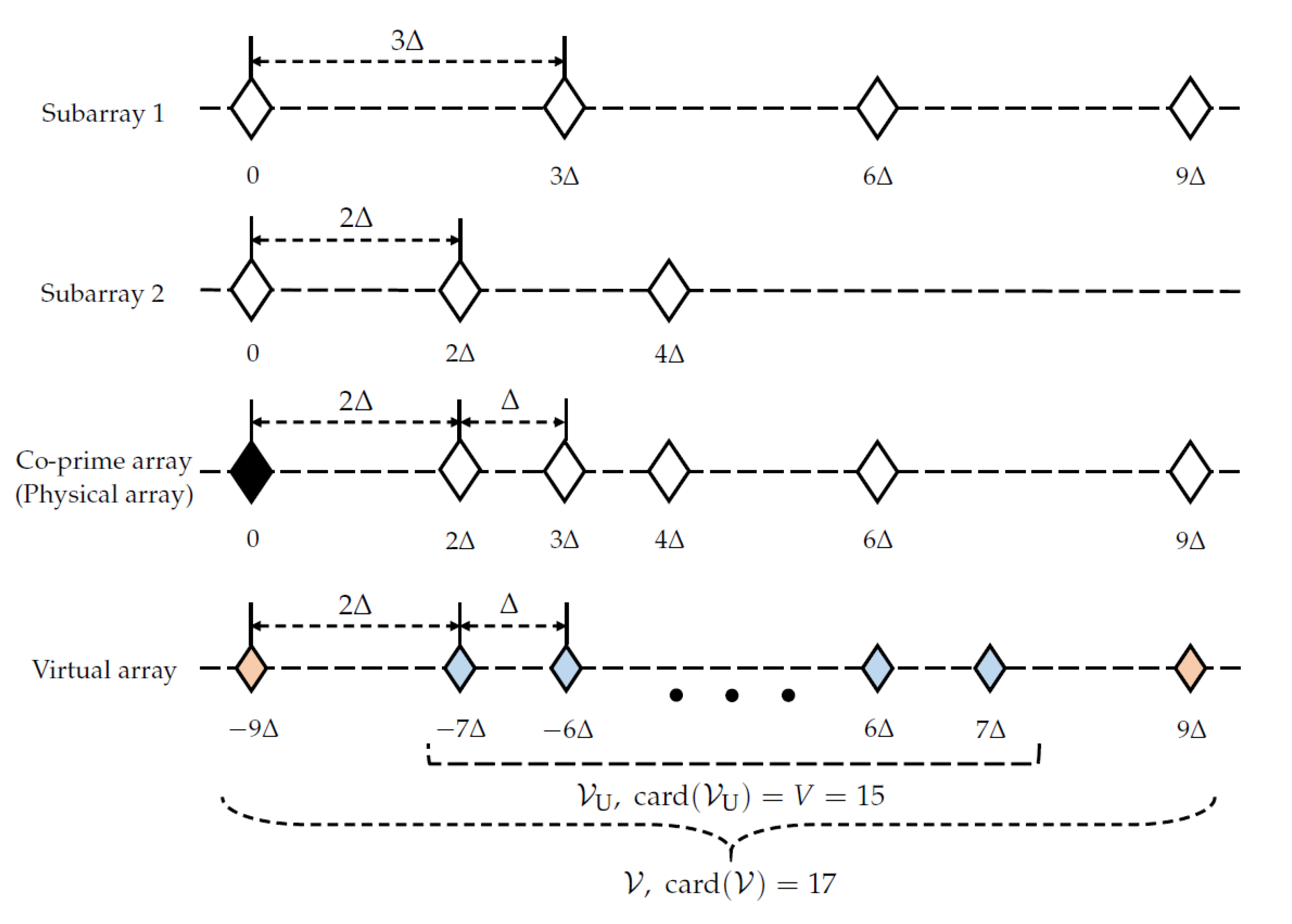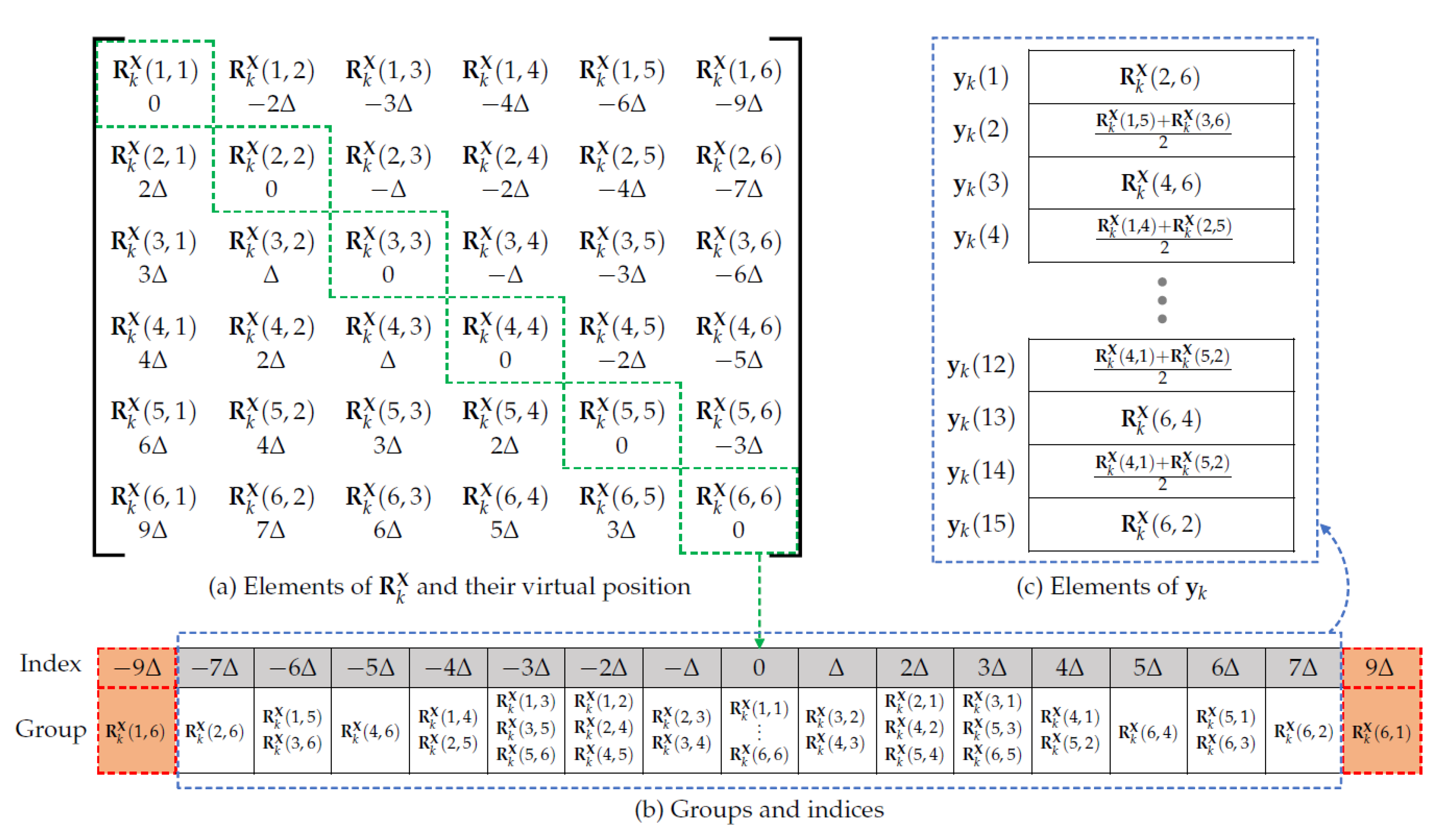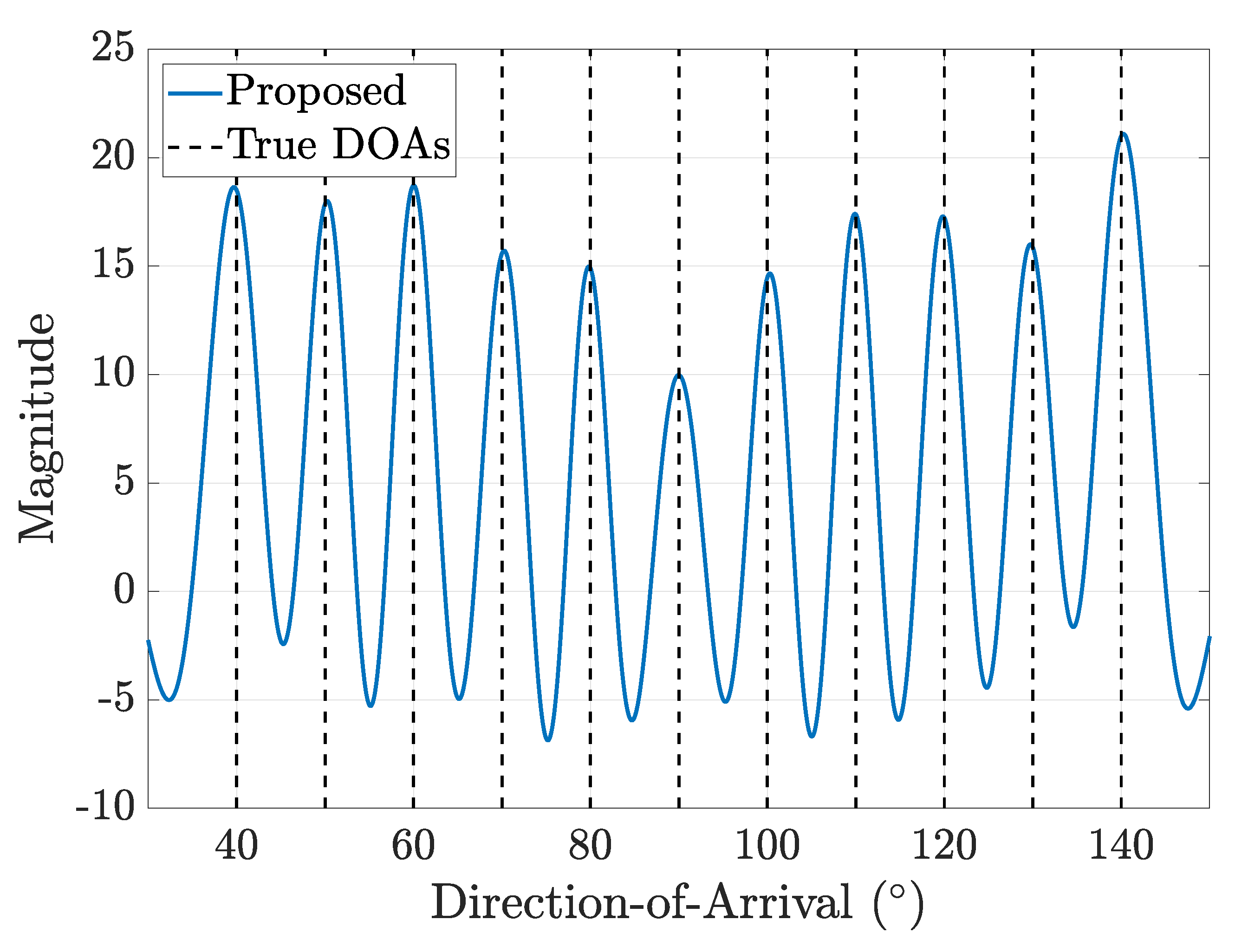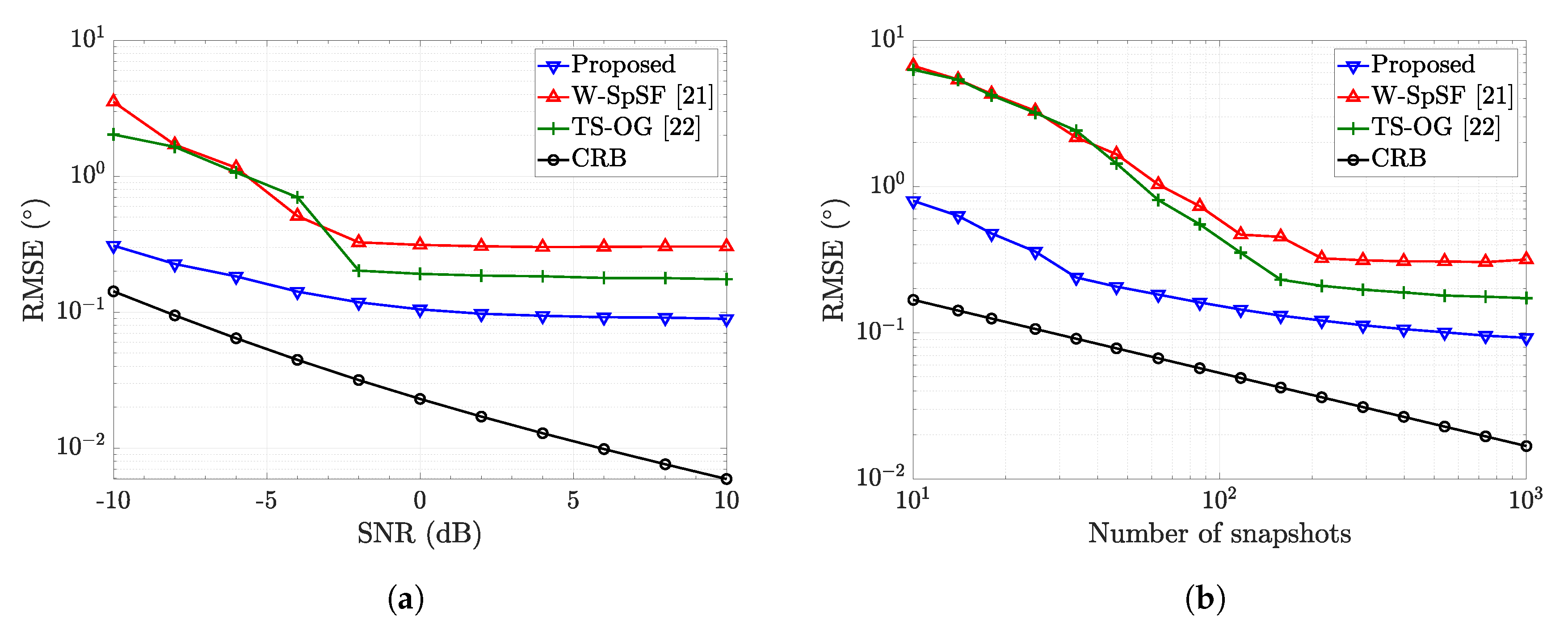Wideband DOA Estimation on Co-prime Array via Atomic Norm Minimization
Abstract
1. Introduction
- An approach based on ANM resolves the grid-mismatch and enables achieving higher accuracy when the signal sources have a wide bandwidth.
- To reduce the complexity of the ANM-based wideband DOA estimation, the time-saving SDP is derived, which is motivated by the ANM for MMV case.
2. Signal Model
3. Wideband DOA Estimation on Co-Prime Array via Atomic Norm Minimization
3.1. Construction of Co-Prime Array Vector
- Group the elements of with the same virtual position as in Figure 2b.Note that the index in Figure 2b denotes the common virtual position of the elements within the group.
- Leave only the groups whose indices are equivalent to the elements of as in Figure 2b.
- Average the elements in remaining groups and vectorize the averaged elements to obtain as in Figure 2c.
3.2. Wideband DOA Estimation via Atomic Norm Minimization
| Algorithm 1 A low complexity wideband DOA estimation on co-prime array via ANM |
| Input: Output: : for all k do ; Construct according to the steps in Figure 2; ; end for ; Calculate via (12); ; Find P largest peaks from to estimate ; |
4. Simulation Result
5. Conclusions
Author Contributions
Acknowledgments
Conflicts of Interest
Appendix A. Derivation of Cramer–Rao Bound
References
- Chen, J.C.; Yao, K.; Hudson, R.E. Source localization and beamforming. IEEE Signal Process. Mag. 2002, 19, 30–39. [Google Scholar] [CrossRef]
- Wymeersch, H.; Seco-Granados, G.; Destino, G.; Dardari, D.; Tufvesson, F. 5G mmWave positioning for vehicular networks. IEEE Wirel. Commun. 2017, 24, 80–86. [Google Scholar] [CrossRef]
- Eom, J.; Kim, H.; Lee, S.H.; Kim, S. DNN-assisted cooperative localization in vehicular networks. Energies 2019, 12, 2758. [Google Scholar] [CrossRef]
- Roy, R.; Kailath, T. ESPRIT-estimation of signal parameters via rotational invariance techniques. IEEE Trans. Acoust. Speech Signal Process. 1989, 37, 984–995. [Google Scholar] [CrossRef]
- Yoon, Y.; Kaplan, L.M.; McClellan, J.H. TOPS: New DOA estimator for wideband signals. IEEE Trans. Signal Process. 2006, 54, 1977–1989. [Google Scholar] [CrossRef]
- Hasch, J.; Topak, E.; Schnabel, R.; Zwick, T.; Weigel, R.; Waldschmidt, C. Millimeter-wave technology for automotive radar sensors in the 77 GHz frequency band. IEEE Trans. Microw. Theory Tech. 2012, 60, 845–860. [Google Scholar] [CrossRef]
- Oppermann, I.; Himilinen, M.; Linatti, J. UWB: Theory and Applications; Wiley: Boca Raton, FL, USA, 2004. [Google Scholar]
- Wang, H.; Kaveh, M. Coherent signal-subspace processing for the detection and estimation of angles of arrival of multiple wide-band sources. IEEE Trans. Acoust. Speech Signal Process. 1985, 33, 823–831. [Google Scholar] [CrossRef]
- Hung, H.; Kaveh, M. Focussing matrices for coherent signal-subspace processing. IEEE Trans. Acoust. Speech Signal Process. 1988, 36, 1272–1281. [Google Scholar] [CrossRef]
- Di Claudio, E.D.; Parisi, R. WAVES: Weighted average of signal subspaces for robust wideband direction finding. IEEE Trans. Signal Process. 2001, 49, 2179–2191. [Google Scholar] [CrossRef]
- He, Z.; Shi, Z.; Huang, L.; So, H.C. Underdetermined DOA estimation for wideband signals using robust sparse covariance fitting. IEEE Signal Process. Lett. 2015, 22, 435–439. [Google Scholar] [CrossRef]
- Shen, Q.; Cui, W.; Liu, W.; Wu, S.; Zhang, Y.D.; Amin, M.G. Underdetermined wideband DOA estimation of off-grid sources employing the difference co-array concept. Signal Process. 2017, 130, 299–304. [Google Scholar] [CrossRef]
- Shi, Y.; Mao, X.; Zhao, C.; Liu, Y. Underdetermined DOA estimation for wideband signals via joint sparse signal reconstruction. IEEE Signal Process. Lett. 2019, 26, 1541–1545. [Google Scholar] [CrossRef]
- Chen, S.S.; Donoho, D.L.; Saunders, M.A. Atomic decomposition by basis pursuit. SIAM J. Sci. Comput. 1999, 20, 33–61. [Google Scholar] [CrossRef]
- Wipf, D.P.; Rao, B.D. Sparse Bayesian learning for basis selection. IEEE Trans. Signal Process. 2004, 52, 2153–2164. [Google Scholar] [CrossRef]
- Shen, Q.; Liu, W.; Cui, W.; Wu, S. Underdetermined DOA estimation under the compressive sensing framework: A review. IEEE Access 2016, 4, 8865–8878. [Google Scholar] [CrossRef]
- Chi, Y.; Scharf, L.L.; Pezeshki, A.; Calderbank, A.R. Sensitivity to basis mismatch in compressed sensing. IEEE Trans. Signal Process. 2011, 59, 2182–2195. [Google Scholar] [CrossRef]
- Yang, Z.; Xie, L.; Zhang, C. Off-grid direction of arrival estimation using sparse Bayesian inference. IEEE Trans. Signal Process. 2013, 61, 38–43. [Google Scholar] [CrossRef]
- Tang, G.; Bhaskar, B.N.; Shah, P.; Recht, B. Compressed sensing off the grid. IEEE Trans. Inf. Theory 2013, 59, 7465–7490. [Google Scholar] [CrossRef]
- Chandrasekaran, V.; Recht, B.; Parrilo, P.A.; Willsky, A.S. The convex geometry of linear inverse problems. Found. Comput. Math. 2012, 12, 805–849. [Google Scholar] [CrossRef]
- Yang, Z.; Xie, L. Exact joint sparse frequency recovery via optimization methods. IEEE Trans. Signal Process. 2016, 64, 5145–5157. [Google Scholar] [CrossRef]
- Bhaskar, B.N.; Tang, G.; Recht, B. Atomic norm denoising with applications to line spectral estimation. IEEE Trans. Signal Process. 2013, 61, 5987–5999. [Google Scholar] [CrossRef]
- Chen, P.; Cao, Z.; Chen, Z. A new atomic norm for DOA estimation with gain-phase errors. arXiv 2019, arXiv:eess.SP/1910.02207. [Google Scholar]
- Tian, Z.; Zhang, Z.; Wang, Y. Low-complexity optimization for two-dimensional direction-of-arrival estimation via decoupled atomic norm minimization. In Proceedings of the 2017 IEEE 2017 IEEE International Conference on Acoustics, Speech, and Signal Process (ICASSP), New Orleans, LA, USA, 5–9 March 2017; IEEE: Piscatawayy, NJ, USA, 2017; pp. 3071–3075. [Google Scholar]
- Tang, W.; Jiang, H.; Pang, S. Grid-free DOD and DOA estimation for MIMO radar via duality-based 2D atomic norm minimization. IEEE Access 2019, 7, 60827–60836. [Google Scholar] [CrossRef]
- Cui, Y.; Wang, J.; Qi, J.; Zhang, Z.; Zhu, J. Underdetermined DOA estimation of wideband LFM signals based on gridless sparse reconstruction in the FRF domain. Sensors 2019, 19, 2383. [Google Scholar] [CrossRef] [PubMed]
- Pal, P.; Vaidyanathan, P.P. Nested arrays: A novel approach to array processing with enhanced degrees of freedom. IEEE Trans. Signal Process. 2010, 58, 4167–4181. [Google Scholar] [CrossRef]
- Vaidyanathan, P.P.; Pal, P. Sparse sensing with co-prime samplers and arrays. IEEE Trans. Signal Process. 2011, 59, 573–586. [Google Scholar] [CrossRef]
- Qin, S.; Zhang, Y.D.; Amin, M.G. Generalized coprime array configurations for direction-of-arrival estimation. IEEE Trans. Signal Process. 2015, 63, 1377–1390. [Google Scholar] [CrossRef]
- Zhou, C.; Gu, Y.; Fan, X.; Shi, Z.; Mao, G.; Zhang, Y.D. Direction-of-arrival estimation for coprime array via virtual array interpolation. IEEE Trans. Signal Process. 2018, 66, 5956–5971. [Google Scholar] [CrossRef]
- Zhang, Y.D.; Amin, M.G.; Himed, B. Sparsity-based DOA estimation using co-prime arrays. In Proceedings of the 2013 IEEE International Conference on Acoustics, Speech, and Signal Process, Vancouver, BC, Canada, 26–31 May 2013; IEEE: Piscataway, NJ, USA, 2013; pp. 3967–3971. [Google Scholar] [CrossRef]
- Pólik, I.; Terlaky, T. Interior point methods for nonlinear optimization. In Nonlinear Optimization; Di Pillo, G., Schoen, F., Eds.; Springer: Berlin, Germany, 2010; pp. 215–276. [Google Scholar] [CrossRef]
- Grant, M.; Boyd, S. CVX: Matlab Software for Disciplined Convex Programming, Version 2.1. 2014. Available online: http://cvxr.com/cvx (accessed on 7 October 2019).
- Stoica, P.; Larsson, E.G.; Gershman, A.B. The stochastic CRB for array processing: A textbook derivation. IEEE Signal Process. Lett. 2001, 8, 148–150. [Google Scholar] [CrossRef]




© 2020 by the authors. Licensee MDPI, Basel, Switzerland. This article is an open access article distributed under the terms and conditions of the Creative Commons Attribution (CC BY) license (http://creativecommons.org/licenses/by/4.0/).
Share and Cite
Chung, H.; Mi Park, Y.; Kim, S. Wideband DOA Estimation on Co-prime Array via Atomic Norm Minimization. Energies 2020, 13, 3235. https://doi.org/10.3390/en13123235
Chung H, Mi Park Y, Kim S. Wideband DOA Estimation on Co-prime Array via Atomic Norm Minimization. Energies. 2020; 13(12):3235. https://doi.org/10.3390/en13123235
Chicago/Turabian StyleChung, Hyeonjin, Young Mi Park, and Sunwoo Kim. 2020. "Wideband DOA Estimation on Co-prime Array via Atomic Norm Minimization" Energies 13, no. 12: 3235. https://doi.org/10.3390/en13123235
APA StyleChung, H., Mi Park, Y., & Kim, S. (2020). Wideband DOA Estimation on Co-prime Array via Atomic Norm Minimization. Energies, 13(12), 3235. https://doi.org/10.3390/en13123235






